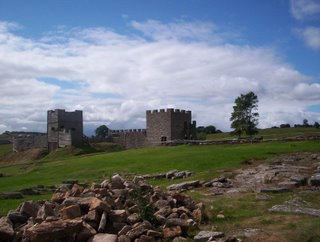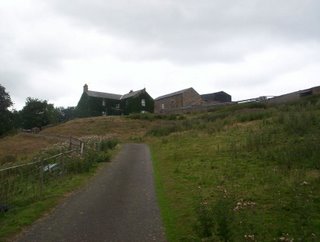The earlier fort was made of wood, the later of stone. This photo shows a reproduction on the site of buildings from both periods:

And here is a picture of part of the ongoing excavation on the site, taken from the stone tower in the first photo. This area is from the later period, with stone buildings:

Below is a Roman bathhouse from the early (pre-Hadrianic, epigraphically rich) period.

Despite its minor status as a Roman fort, Vindolanda is extraordinarily important for the epigraphic discoveries that have poured out of it since the early 1970s. Hundreds (thousands?) of thin wooden writing tablets have been recovered from the earliest strata. These inscribed tablets survived with writing intact (recoverable through infra-red photography) because these early layers (late first and early second century) were leveled, covered over with clay and then new sod, and built over. This sealed the early strata into what quickly became an anerobic environment that arrested the decomposition of organic matter until the excavators rediscovered it. You can read in detail about the epigraphic remains from Vindolanda here. My favorite is the birthday party invitation to Lepidina, the wife of the commander of the fort. Lepidina's family, who were real people, are the main characters in the Minimus books and the birthday of her friend is recounted in the first one. The Vindolanda texts were voted the number one treasure of the British Museum, and rightly so. They are as important for the early history of Britain and the history of the Roman Empire as the Dead Sea Scrolls are for early Judaism. The content of the Vindolanda tablets and the Dead Sea Scrolls are quite different and each leaves us with important gaps. The Vindolanda tablets are documentary texts (administrative texts, personal letters, etc.) which tell us about day to day life of individuals and about the running of the fort, but which contain almost no literary texts (just a few classical quotations). We are left knowing that they read, but longing to know the contents of their library. The Dead Sea Scrolls preserve the library (or a collection of the libraries) of a first-century Jewish sectarian group, but they include almost no documentary texts. We are thus left knowing all about what literary works they read, but longing to know about who the people in the group were and what their daily lives were like. (The later Judean Desert texts from the period of the Bar Kokhba Revolt -- about a generation after the Vindolanda texts -- are mostly documentary texts, with some literary texts mixed in. But these were not left by the Qumran sectarians and still leave us in the dark about them.)
Despite the gaps, we are extraordinarily lucky to have both the Vindolanda texts and the Dead Sea Scrolls. And in the future, with more luck, it's possible that some of those gaps will be filled in.
Also, while we were in the vicinity, we visited Hadrian's Wall, near the Roman Army Museum. We stayed at a B&B in Haltwhistle. This was at a nice farmhouse built in the ealy 19th century, which is reputed to have been made of stones from the Wall.

And here is a picture of the view from the Wall, looking southeast.

I've also posted another picture of the Wall here. You can click on any of the photos to get a larger image.
UPDATE (14 August): Peter Head e-mails:
I would respectfully suggest that it is not accurate to describe the Vindolanda tablets as "inscribed tablets" and therefore as "epigraphic" discoveries. They are predominantly written by pen in ink on the wood as discussed at the Vindolanda on-line site: "it is also misleading to categorise them, as is usually done, as 'incised' rather than `written' material." (http://vindolanda.csad.ox.ac.uk/tablets/TVI-2-1.shtml)Yes, they are mostly written in ink. It is the carbon ink that makes the writing stand out under infra-red light, as I noted above. It's the same with the Dead Sea Scrolls.
[in a broader discussion]
Thanks for the photos
I use "inscribe" to mean to write on something and "inscription" as something with writing on it. Likewise, I use 'epigraphic" to mean pertaining to ancient inscriptions. Therefore, texts written in ink on ancient surfaces are inscriptions and are of interest to the epigrapher. I don't have a Webster's in my office, but my American Heritage Dictionary agrees with these usages. This is the normal terminology for Northwest Semitic epigrapy (e.g., ink-inscribed ostraca are described as inscriptions and studied by epigraphers). Maybe Classical epigraphers use the terms differently. And there's some wiggle-room, since ancient scrolls generally aren't called inscriptions, although I suppose that technically they are. But I stand by my usage above.
No comments:
Post a Comment